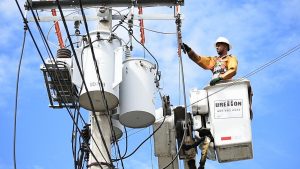To become a licensed electrician, one follows a specific career path: apprentice–journeyman–master.
And on this page, we’ll discuss the second step, which is becoming a licensed journeyman electrician.
As a journeyman, you’re expected to have the knowledge, skills, training, and experience to work independently in the industry.
You’ll work in various settings, including residential, industrial, and commercial construction.
Read on to learn more about the journeyman electricians’ duties, career options, and license qualifications.
What a Journeyman Electrician Does
A journeyman electrician handles a wide array of tasks with zero to little supervision.
In general, your work involves installing, altering, maintaining, and repairing a variety of systems, including:
- Motor control and programmable logic controllers (PLCs)
- Power and lighting systems
- Energy management systems
- Backup power generation systems
- Power distribution and metering systems
- Building automation systems
With the experience you had as an apprentice, you can easily perform the following tasks:
- Read blueprints
- Install lighting and security systems
- Troubleshoot motors and controls
- Terminate cable
- Diagnose and resolve problems in electrical circuits, systems, and equipment
- Handle wire and conduit sizing
- Connect circuit breakers, switches, transformers, and outlets
- Install feeders
- Install and troubleshoot wiring
- Inspect and test existing wiring systems
Other duties that can fall into your jurisdiction include:
- Maintaining an inventory of tools, equipment, and material
- Inspecting jobs to ensure safe and clean work areas
- Selecting material and hardware for time and materials estimates
- Maintaining accurate records regarding material and labor
- Supervising and guiding apprentices
Career Paths of a Journeyman Electrician
As a journeyman electrician, you’ll usually work either as an outside lineman or inside wireman.
Both occupations come with their specific job specifications and responsibilities.
Journeyman Lineman
A journeyman lineman works on electrical power systems, maintaining them from the point of power generation to the power meter.
You will deal with traffic signals and street lights.
Your responsibilities include:
- Installing and maintaining transformers and other equipment
- Assembling and erecting substations
- Setting electric towers and poles
- Stringing new wire and maintaining existing wire
- Installing and maintaining underground distribution systems
- Installing and maintaining insulators
- Maintaining and repairing overhead distribution or transmission lines
Inside Journeyman Wireman
An inside journeyman wireman handles the distribution and connection of electrical equipment to a power source for residential and commercial clients.
You will also work with any type of electrical system inside commercial and industrial facilities.
Your responsibilities include:
- Establishing and maintaining power distribution equipment, including transformers, breakers, and switches
- Installing and maintaining main service panels, including circuit breakers and switching gear
- Building and assembling power generation equipment
- Installing and maintaining process control systems, including energy management systems
- Establishing grounding systems
- Installing and maintaining power feed and control wiring systems
- Installing and repairing telephone and data systems
- Troubleshooting and repairing electrical systems
- Installing new wiring and repairing existing wiring
- Installing conduit and junction boxes
- Maintaining and repairing temporary power systems during construction
- Installing service to buildings and other structures
- Installing receptacles, lighting systems, and fixtures
- Handling the installation and maintenance of security and fire alarm systems
From Apprentice to Journeyman Electrician: License Qualifications
Completing an apprenticeship program is the first step in qualifying for a journeyman electrician license.
Every jurisdiction has its required education and experience requirements, but at a minimum, you must have completed the following:
- 500 to 1,000 hours of classroom training
- 8,000 to 10,000 hours of supervised on-the-job experience
For instance, in Colorado, apprentices should complete at least 8,000 hours in no less than four years for a journeyman license.
These hours include electrical construction wiring experience for power, lights, and heat in commercial and/or industrial construction.
You can also meet the classroom hours requirement by completing an electrician associate’s degree or diploma program before the apprenticeship.
Once you’ve met these requirements, you will need to take and pass the licensure exam.
The exam usually covers the following topics:
- National Electrical Code (NEC)
- Local electrical codes
- Electrical theory
Working toward Becoming a Master Electrician
In the future, after gaining valuable experience, you will want to obtain a master electrician license.
Holding such a license will mean that you have solid competencies and experience in the trade and important regulations.
In addition, you will have the authority to perform the following:
- Pull permits
- Design lighting and wiring systems
- Oversee job sites and lead teams
- Supervise journeymen and guide apprentices
To obtain your master license, you will have to meet the required hours working as a journeyman.
Most jurisdictions require at least two years (4,000 hours) as a journeyman to qualify for licensure.
This page is also available in Spanish.










